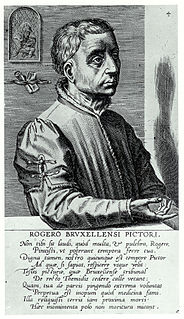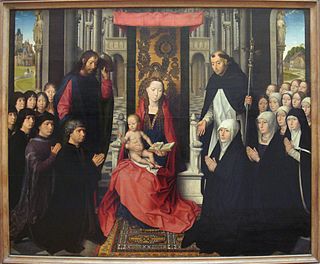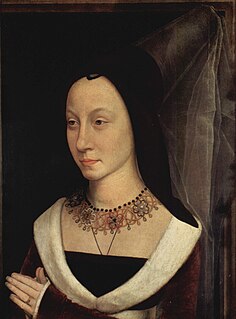Related Research Articles

Rogier van der Weyden or Roger de la Pasture was an Early Netherlandish painter whose surviving works consist mainly of religious triptychs, altarpieces and commissioned single and diptych portraits. He was highly successful in his lifetime; his paintings were exported to Italy and Spain, and he received commissions from, amongst others, Philip the Good, Netherlandish nobility, and foreign princes. By the latter half of the 15th century, he had eclipsed Jan van Eyck in popularity. However his fame lasted only until the 17th century, and largely due to changing taste, he was almost totally forgotten by the mid-18th century. His reputation was slowly rebuilt during the following 200 years; today he is known, with Robert Campin and van Eyck, as the third of the three great Early Flemish artists, and widely as the most influential Northern painter of the 15th century.

Hans Memling was a painter active in Flanders, who worked in the tradition of Early Netherlandish painting. He was born in the Middle Rhine region, and probably spent his childhood in Mainz. He moved to the Netherlands and spent time in the Brussels workshop of Rogier van der Weyden. He was subsequently made a citizen of Bruges in 1465, where he became one of the leading artists, running a large workshop, which painted religious works that often incorporated donor portraits of his wealthy patrons. Memling's patrons included burghers, clergymen, and aristocrats.

Jef Van der Veken was a Belgian art restorer, copyist and art forger, who had mastered the art of reproducing the works of the Early Netherlandish painters.

Petrus Christus was an Early Netherlandish painter active in Bruges from 1444, where, along with Hans Memling, he became the leading painter after the death of Jan van Eyck. He was influenced by van Eyck and Rogier van der Weyden and is noted for his innovations with linear perspective and a meticulous technique which seems derived from miniatures and manuscript illumination. Today, some 30 works are confidently attributed to him. The best known include the Portrait of a Carthusian (1446) and Portrait of a Young Girl ; both are highly innovative in the presentation of the figure against detailed, rather than flat, backgrounds.

Master of the Embroidered Foliage was a Netherlandish painter or a group of painters who worked out of Bruges and Brussels.

The Descent from the Cross is a panel painting by the Flemish artist Rogier van der Weyden created c. 1435, now in the Museo del Prado, Madrid. The crucified Christ is lowered from the cross, his lifeless body held by Joseph of Arimathea and Nicodemus.

François-Joseph Kinson, was a Flemish painter.

Portrait of a Lady is a small oil-on-oak panel painting executed around 1460 by the Netherlandish painter Rogier van der Weyden. The composition is built from the geometric shapes that form the lines of the woman's veil, neckline, face, and arms, and by the fall of the light that illuminates her face and headdress. The vivid contrasts of darkness and light enhance the almost unnatural beauty and Gothic elegance of the model.

The Lamentation of Christ is an oil-on-panel painting of the common subject of the Lamentation of Christ by the Netherlandish artist Rogier van der Weyden, dating from around 1460–1463 and now in the Uffizi Gallery, Florence, Italy.

Crucifixion Diptych — also known as Philadelphia Diptych, Calvary Diptych, Christ on the Cross with the Virgin and St. John, or The Crucifixion with the Virgin and Saint John the Evangelist Mourning — is a diptych by the Early Netherlandish artist Rogier van der Weyden, completed c. 1460, today in the Philadelphia Museum of Art. The panels are noted for their technical skill, visceral impact and for possessing a physicality and directness unusual for Netherlandish art of the time. The Philadelphia Museum of Art describes work as the "greatest Old Master painting in the Museum."

Jean-Bernard Duvivier was a painter and drawer of portraits and historical and religious subjects, a book illustrator and a professor at the Normal School in Paris. After having been instructed by Hubert and Paul de Cock and Suvée, he studied in Italy for six years. His style is characterised by balanced composition, lifelike drawing and bright colours.
Till-Holger Borchert is a German art historian and writer specialising in 14th and 15th-century art. He has been the chief curator of the Groeningemuseum and Arentshuis museums in Bruges, Belgium, between 2003 and 2014. In December 2014, he was appointed as director of the Municipal Museums in Bruges.

The Exposition des primitifs flamands à Bruges was an art exhibition of paintings by the so-called Flemish Primitives held in the Provinciaal Hof in Bruges between 15 June and 5 October 1902.

Elisabeth Dhanens was a Belgian art historian specialising in Early Netherlandish painting.

Joseph Denis Odevaere, or Joseph-Désiré Odevaere, was a Neo-Classical painter from the Southern Netherlands. He served as court painter to King William I.

The Annunciation is an oil painting on oak panel attributed to Early Netherlandish painter Hans Memling. It depicts the Annunciation, the archangel Gabriel's announcement to the Virgin Mary that she would conceive and become the mother of Jesus, described in the Gospel of Luke. The painting was completed c. 1482 and was partially transferred to canvas in the 1920s; it is today held in the Robert Lehman collection of the Metropolitan Museum of Art in New York.

Portrait of Maria Portinari is a small c. 1470–72 painting by Hans Memling in tempera and oil on oak panel. It portrays Maria Maddalena Baroncelli, about whom very little is known. She is about 14 years old, and depicted shortly before her wedding to the Italian banker Tommaso Portinari. Maria is dressed in the height of late fifteenth-century fashion, with a long black hennin with a transparent veil and an elaborate jewel-studded necklace. Her headdress is similar and necklace identical to those in her depiction in Hugo van der Goes's later Portinari Altarpiece, a painting that may have been partly based on Memling's portrait.

Bathsheba are names given to a c 1480 oil on wood panel painting by the Early Netherlandish artist Hans Memling, now in the Staatsgalerie, Stuttgart. Its unusually close framing and the fact that many of the details are cut off suggests that it is a fragment of a larger, probably religious, panel or triptych that was broken up. The painting is noted for being a rare 15th century depiction of a nude person in Northern Renaissance art; such figures typically only appeared in representations of the Last Judgement, and were hardly as deliberately erotic. Memling is attributed one other secular nude portrait, in the center panel of his c. 1485 Vanitas allegory Triptych of Earthly Vanity and Divine Salvation, at the Musée des Beaux-Arts, Strasbourg. As opposed to Bathsheba, that nude is fully exposed, with visible genitalia.

The Moreel Triptych is the name given to a 1484 panel painting by the Early Netherlandish painter Hans Memling. It was commissioned by the prominent Bruges politician, merchant and banker Willem Moreel and his wife Barbara van Vlaenderberch, née van Hertsvelde. It was intended as their epitaph at the chapel of the St. James's Church, Bruges, an extension they paid for, to the funerary church of Willem's family, where the couple intended to be interred in an underground tomb before the altar.

Portrait of a Man in a Red Hat is an 1465-1470 oil on oak panel painting by Hans Memling, one of the first portraits he produced in Bruges, with similarities to his Portrait of a Man - its subject is unknown. It has some similarities to portraits by Jan van Eyck and Rogier van der Weyden, though the fictive stone frame is Memling's invention.
References
- ↑ "Eerste schoolreünie na vijftig jaar". Het Nieuwsblad . 11 Oct 2011.
- ↑ Lauran Toorians (1994). "Planken, verf en handelsgeest: 500 jaar Hans Memling". Ons Erfdeel . 37.
- ↑ Lorne Campbell (Apr 1995). "Bruges: Hans Memling". The Burlington Magazine . Vol. 137 no. 1105. pp. 264–265.
- ↑ "Nieuwe Catalogi voor Groeninge en Gruuthuse". Biekorf . No. 80. 1980.
- ↑ Lorne Campbell (Apr 1995). "Hans Memling, The Complete Works by Dirk de Vos". The Burlington Magazine . Vol. 137 no. 1105. pp. 253–254.
- ↑ Dan Ewing (2006). "The Flemish Primitives: The Masterpieces by Dirk de Vos". Sixteenth Century Journal . 37 (1): 258–259.